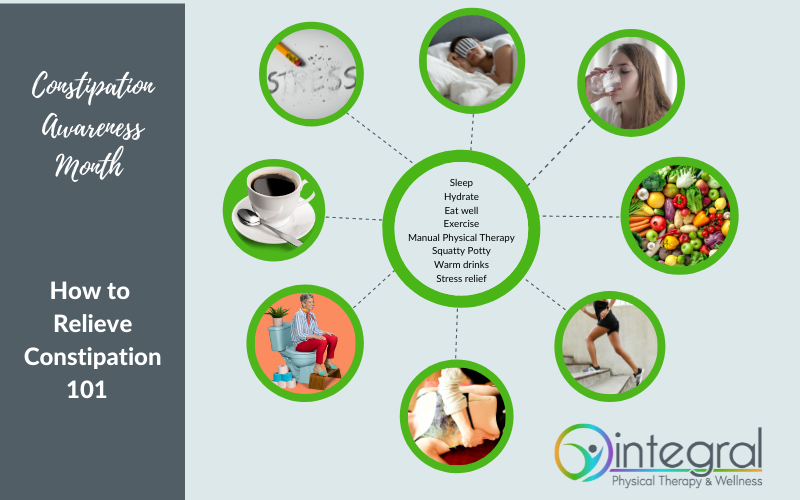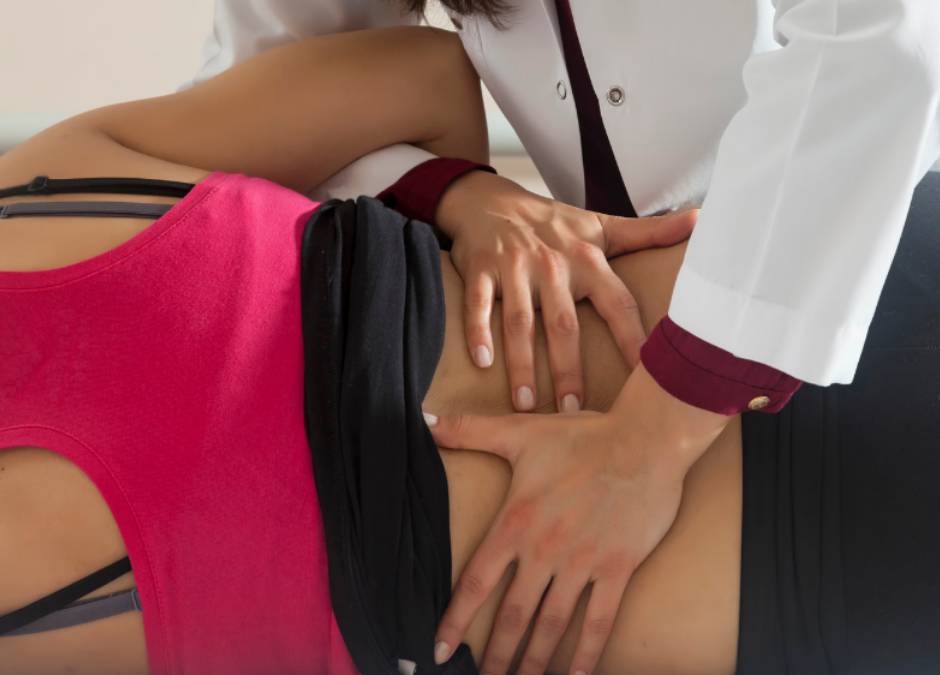Constipation is a very common condition, affecting nearly everyone at some point in our lives. Most of us inwardly groan when thinking about how our system responds to travel, or how certain medications might affect us, and nearly all women who have been through pregnancy can identify with the discomfort of constipation. However, constipation, while common, is abnormal and when it is chronic it can be an indicator of pelvic floor dysfunction, gut dysfunction, and more. It can be absolutely miserable, but the great news is that there are ways to combat constipation and improve ease of bowel movements! In this article, we will cover some tips that may help you with constipation and tell you how specially trained pelvic health physical therapists successfully treat constipation in patients with a variety of techniques. Gut health is intricately tied to our overall health, so let’s make sure we are all having great poops!
What exactly is constipation?
The American Gastroenterological Association (AGA) defines chronic constipation as fewer than 3 stools per week for 3 weeks or more. It is also possible to have a bowel movement every day and still be constipated! In fact, we see this often in patients. As a prominent Atlanta urologist, Dr. Kirsch, once said to me, “It’s not what comes out that counts, it’s what doesn’t.”
How do you know if you are constipated? If you…
- have to strain with bowel movements (i.e., breath-holding and pushing),
- have stool that is hard/lumpy,
- have pain with bowel movements,
- have bloating and abdominal fullness,
- have a sensation of incomplete bowel emptying, or
- stool less than daily (or 3x/week by official definition)
…then you are likely constipated. That being said, each person has a different frequency of bowel movements. It is possible that having 3 bowel movements a week is normal for you, and if so, that is perfectly okay as long as you are not having any of the other symptoms listed above. I have not yet, however, met many people who feel great when pooping less than daily. Look at the Bristol Stool Chart to see how your poo ranks. Types 3 and 4 are considered normal, 1 and 2 are constipated, and 5 and 6 are excessively loose (we’ll talk about 5’s and 6’s in another post).
So why is constipation a bad thing?
Aside from causing generalized discomfort in the abdomen, rectum, low back, and pelvis, constipation is the number one contributor to urinary incontinence. It is the cause of bedwetting and leaking in children in the vast majority of cases (98%+) because the full colon presses against the bladder. It can lead to various types of incontinence in adults. It can be a contributor to stress incontinence in athletes. It can also eventually lead to vaginal/rectal prolapse due to excessive straining. It causes painful hemorrhoids and anal fissures. Regular stooling is an important part of how our bodies detox and eliminate not only food waste but also other waste products. Constipation can tell us that our gut microbiome is not optimal, which has been associated with a wide variety of health conditions from allergies to chronic fatigue and more. Regular elimination also assists with healthy estrogen metabolism and hormone balance. In a small percentage of cases, constipation can be an indicator of a more serious gut condition. In all cases, it should not be ignored.
What causes constipation?
There are many factors that can contribute to constipation, and typically multiple reasons for each person.
- Nutrition and Hydration: The types of food you eat, the amount of fiber in your diet, and the amount of water you drink influence the type and size of poop. We’ll review helpful nutritional tips below.
- Lack of regular exercise: Exercise increases bowel motility, which means stool moves through your intestines faster. Being sedentary slows all metabolic functions.
- Stress: Our parasympathetic nervous system is associated with “rest and digest”, and most of us could use a little more parasympathetic activation. Our modern lifestyles often keep us in sympathetic overdrive, which means that digestion is slowed and constipation is a problem.
- Hormone fluctuations or imbalance: Thyroid and reproductive hormones play a role in bowel function. Having your levels checked is a great thing to consider if you have chronic constipation. Excess of the stress hormone cortisol also contributes, as do insulin issues. Hormone fluctuation in pregnancy is one of the more common reasons for constipation, particularly during the 1st trimester.
- Gut microbiome: Our gut flora can be disrupted for a host of reasons and dysbiosis can contribute to constipation and/or diarrhea.
- Certain bowel disorders such as ulcerative colitis or irritable bowel syndrome can cause fluctuating diarrhea and constipation. Optimally controlling inflammation is key and requires a complex team holistic approach.
- Fluctuating schedules: Routines are important in establishing good biological rhythms that help sleep and digestion, which is why travel is often an issue.
- Certain medications including pain medications, certain antacids, diuretics, blood pressure medications, antianxiety medications, and others commonly cause constipation.
- Iron supplements: Ask your provider if a different form of iron might be helpful for you. Ferrous bisglycinate is typically better tolerated.
- Another very common contributor is “holding it”: chronically holding stool in due to lack of desire to use a public restroom or due to a busy schedule. When you hold stool in, water is reabsorbed into the body from the colon, making the stool drier and harder to pass. Teachers and nurses often have this problem due to job demands. It is also extremely common in kids.
- Scar tissue: The mobility and function of your internal organs can be affected by previous abdominal surgeries and scar tissue. Lower abdominal surgeries are common culprits.
- Overuse of laxatives: The gut can become dependent and sluggish after repeated laxative use.
- Another cause can be slow gut motility, or “colonic transit time.” If other possibilities have been ruled out, physicians can assess CTT with testing by having you swallow a special pill.
- Abnormal pelvic floor function
How does your pelvic floor affect your bowel movements?
In order to have a bowel movement, your pelvic floor muscles need to relax and elongate to allow stool to exit the body. People with chronic constipation are frequently found to have pelvic floor muscle tightness and trigger points and may have difficulty fulling relaxing their pelvic floor muscles to empty correctly. If you have increased tension in these muscles, the anus cannot open as far. A smaller opening means increased force is required to push the stool out, which is why so many people feel the need to strain. A vicious cycle can develop: a painful stool triggers a reflexive pelvic floor muscle contraction during stooling as the brain attempts to protect against more pain, which then causes incomplete emptying, which leads to water reabsorption and drier stool, which then increases constipation and the likelihood of a painful stool, as so forth. In many cases, pain is not a problem but the pelvic floor is not reflexively relaxing. Typically the patient is completely unaware of the pelvic floor contracting instead of relaxing. This paradoxical pelvic floor muscle contraction during defecation is referred to as dyssynergic defecation. This study reports that it is a problem in up to half of people with constipation. This video describes normal and abnormal stooling well. And in some patients with a history of low back, sacroiliac, or coccyx (tailbone) pain, there is increased myofascial tension and trigger points through the hip and pelvic muscles (glutes, hip rotators, coccygeus, levator ani) which contribute to decreased mobility and relaxation of the rectum and anus. Great news, any pelvic floor contribution to constipation responds very well to physical therapy treatments.
What can you do to resolve constipation?
Even if you have had constipation for years, there are things you can do to help improve your bowel movements and eliminate the constant struggle!
Eating routine
Eat at regular intervals
Eat slowly and chew your food adequately
Hydration
Drink half of your body weight in ounces as a baseline, but more may be required depending on your exercise level and for nursing mamas.
Fiber
Typically 25-28 grams per day is recommended for women and about 35 grams per day for men. If you eat less than that, we advise adding fiber in slowly as you increase to the recommended daily amount. And if you are adding fiber to your diet, do so throughout the day as opposed to all at once, and drink more water to balance the fiber.
Do eat: A balanced diet. Healthy fats such as olive oil, avocados, and nut spreads. Lots of fruits and veggies. Foods containing soluble and insoluble fiber. Some of the best sources of soluble fiber include oats, peas, beans, oranges, apples, flaxseed, and carrots. Soluble fiber absorbs water and helps keep stool a good consistency. Some of the best sources of insoluble fiber include dark green leafy vegetables, seeds, nuts, beans, potatoes, bran, and whole grains. Insoluble fiber does not absorb water and adds bulk to your stool. Both fiber types are associated with decreased health risks for such conditions as diabetes, diverticulitis, and cardiovascular disease.
Eat less: Processed grains such as white rice, white bread, etc. which are lower in fiber and nutritional content. These are constipating foods. Eat the opposite of the BRAT diet which is used for diarrhea (bananas, rice, applesauce, and toast {note that less ripe bananas and white rice/toast are the ones associated with the BRAT diet}).
Toilet Posture
Another helpful tool is using a stool to place your feet on while you are on the toilet. Ideally, your knees should be above your pelvis, which helps to relax the pelvic floor and helps to straighten out the rectum, giving your stool an easier and more direct route out of the body. You also want your knees to be wide, not together. We recommend the Squatty Potty, and if you haven’t had the pleasure of seeing the unicorn video, do check it out. This video is a less comical and more straightforward description.
Defecation Mechanics
E.g. “How to Poop.” Many people hold their breath and squeeze their stomach muscles to stool. However, it is best to avoid breath-holding and straining. Note that there is a huge difference between relaxing the pelvic floor and straining/excessively bulging the pelvic floor and many people require instruction in order to understand the difference. There is a specific sequence that we know aids in stooling effectively and safely.
1. Assume proper toileting posture, hopefully with knees high and wide using a stool.
2. Inhale, fill your belly, “Belly Big”
3. As you hold the pressure in your belly, resume normal breathing and tighten the abdominal muscles for “Belly Hard.” Note that you are not flattening your abs or pulling them in, you are adding tension to the belly as it says inflated.
4. Gently bear down and gently bulge the pelvic floor as you continue to tighten the abdominal muscles while breathing out.
5. Lastly, if you are mid-poop and feel like it’s not all coming out, DO NOT hold your breath! Continue to breathe through it (I promise, it makes a big difference!). As you are passing the stool, do this with your exhale gently (try making a shhh sound). Assume proper sitting position (see above)
6. Take your time, try not to rush. Also, don’t sit too long. 10-15 minutes should be plenty of time and longer periods can promote excessive pressure issues like prolapse and hemorrhoids.
**Here are the Never’s:
Never hold your breath and bear down
Never hover to stool
Exercise
If you aren’t getting enough daily movement and exercise, consider adding some in. Take the stairs when you can. Park your car farther away. Do laps around your house and up and down the stairs in between conference calls or put on an exercise video while the kids are sleeping. Try to take daily walks at least 15-20 minutes.
Breathing
Diaphragmatic (belly) breathing is an extremely helpful activity that will help promote natural relaxation of the pelvic floor. This can be performed in multiple different positions, like in child’s pose with knees apart, happy baby, and butterfly pose, all of which help with relaxation of the pelvic floor by having the knees spread apart. This video is a great review of how to breathe more diaphragmatically.
Supplements
Supplements like fiber, prebiotics, probiotics, and magnesium can help improve gut health to make bowel movements easier, but always ask your physician before taking any new supplements. Magnesium oxide, magnesium citrate, and magnesium sulfate all improve constipation symptoms. Magnesium citrate is our favorite.
Mindfulness and Relaxation
Stress relief activities can help improve activation of your parasympathetic nervous system which can greatly improve digestion and gut motility. This can mean different things for different people. Whatever brings you joy or a sense of peace can be helpful, like a hobby, hanging out with friends, watching a funny movie, or taking your dog to the park. It is also helpful for many people to include guided relaxation. The Calm app and Headspace can be really helpful. If you have the Breathing app on your phone or watch, use it to remember to take deep breaths throughout your day. Taking a bath at the end of the day, and working on a consistent bedtime routine and schedule can also help overall stress levels and gut function.
Try a schedule
It can be difficult to try to have a bowel movement first thing in the morning if your mornings are rushed, but that is the time of day that most people’s bowels like to move under the right conditions. Consider getting up an extra 15 minutes early. Try eating something that promotes stooling like oatmeal, drinking warm tea or coffee, and sitting down on the toilet 15-30 minutes afterwards. It is highly possible that over time this routine will contribute to a regular morning poop. Our bodies really like rhythms, and you will feel so much better.
Don’t ignore the urge to go
No matter where you are, either trying to get the kids in the car seat, running through the airport or standing in front of a classroom, try to allow yourself the ability to go to the bathroom even if it’s inconvenient. If you ignore the urge, it will usually go away. However, that is not a good thing as it causes the stool to harden as described above.
Physical Therapy
Last but absolutely not least, is physical therapy. PT sessions include a thorough history review, musculoskeletal assessment, individual assessment of bowel and bladder habits, lots of education, and referral to other professionals when appropriate. They also often include muscle retraining, postural retraining, and manual therapy to correct alignment and treat any areas of myofascial tightness or scar tissue that are present. Biofeedback is a method of assessing the ability of your pelvic floor to contract and relax and is a necessary part of a thorough constipation assessment. Many patients report significant improvement of symptoms within 1-2 sessions.
If you struggle with constipation, the road to relief is much faster if you see a physical therapist specializing in pelvic health. A personalized approach is most helpful in improving constipation. Let’s get you pooping better! Contact us now to schedule an appointment or a free 15-minute phone call to see if PT is a good fit for you.
*Blog content is for informational purposes only, and is not considered medical advice.





